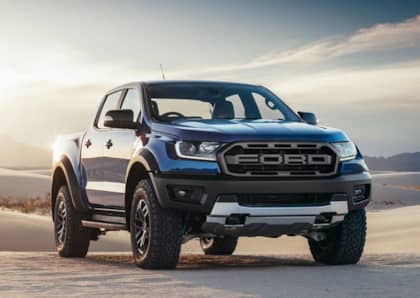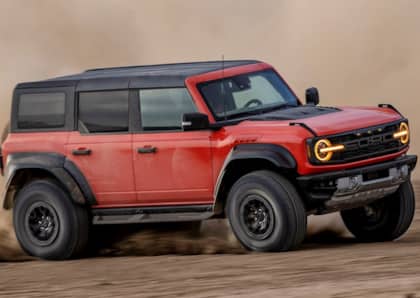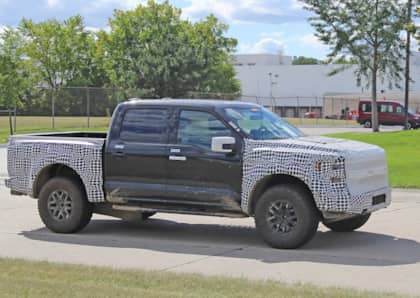Ford's Baja Truck History Helped Build The F-150 Raptor Into The Off-Road Weapon It Is Today
The Ford F-150 Raptor—despite the recent threat of the Ram 1500 TRX Hellcat truck—has become the gold standard for high speed off-road shenanigans. This ultra-quick, super-tough pickup didn't just appear out of thin air, however. It built on Ford's surprisingly deep history of off-road competition that includes impressive success in one of the most famous desert races of them all: the Baja 1000.

The Raptor is the latest link in a chain of trucks and SUVs that goes back to the very beginning of competitive Baja racing. Understanding the Blue Oval's current off-road vehicle roster means taking a look at its past and discovering the vehicles that taught Ford the lessons it needed to bring a beast like the F-150 Raptor to market.
Baja Beginnings
Although timed runs through the Baja Peninsula had been taking place since the early 1960s, it wasn’t until 1967 that the first official race was organized. Then called the 'Mexican 1000,' the event began in Tijuana and went all the way to La Paz, which was just under 850 miles in total.

By 1969, Ford was attracted enough by the pull of the National Off-Road Racing Association race to make its first entry. It took the form of a 1969 Bronco, piloted by Rod Hall who had won his class in the original Mexican 1000. The Ford Bronco was a relative newcomer to the off-road scene at the time, and unlike most of the other entries in the race it retained its four-wheel drive system as a key part of its running gear (with rear-wheel drive the most popular choice for desert action).

Hall won the event, and to this day remains the only overall race champion to do so with a 4x4 (the crowning achievement of his 24 individual class wins at the Baja 1000). The following year, Ford would turn to Bill Stroppe, who had built the first-place Bronco, to put together an even more hardcore version of the racer to be driven by Indy Car legend Parnelli Jones.

The first vehicle employed an I-beam front suspension outfitted with a double-shock absorber setup, and it left four-wheel drive behind for a rear-wheel drive layout, ultimately winning its class. In 1970, with the 1000 firmly in its sights, Ford and Stroppe put together 'Big Oly,' a tubeframe Bronco named after its Olympia Beer sponsor. In addition to its radically reinforced chassis, the SUV traded its roof for an adjustable wing and featured a 400 horsepower 351 cubic inch V8 under the hood. It went on to win in both 1970 and 1971, breaking records in the process (with the second effort shaving over an hour from the quickest-ever time). The truck took the checker in the 1973 Baja 500 as well as the Mint 400 that same year.
Promising '80s Leads To Dominant '90s
Ford would score its next overall win at the Baja 1000 in 1992. It had been dominant in several classes of off-road racing throughout the 1980s, again by partnering with Bill Stroppe who put together Courier and Ranger pickups that would win seven SCORE (Southern California Off Road Enthusiasts) titles, including four in a row towards the end of the decade. Much of this success was tied to driver Manny Esquerra, who became a key part of the company's racing program in Class 7 competition.

SCORE competition would continue to be strong in the 1990s for Ford, with 20 championships picked up by its large stable of drivers and teams. Its two of its crowning achievements were a 1989 Baja 1000 title with Robby Gordon at the wheel of one of its purpose-built desert racing trucks, and Paul and Dave Simon also winning overall in 1992 with a Ford Ranger.

The latter was part of Ford's 'Rough Riders' program that dramatically advanced the quality of its off-road racing in that era.
Factory Ambitions Define The 2000s
The 2000s proved to be a very fruitful period for Ford's Baja 1000 efforts, which no doubt lead the company to reconsider what it had to offer in its showrooms. With 7 overall wins from 2000 to 2010, Ford also mixed in testing of what would become the first-generation SVT Raptor, taking a third place finish in 2008 in Class 8 racing. This version of the Raptor was fairly close to the stock version that went on sale as a 2010 model (despite its Raptor R badging), and it provided exceptional hardcore testing for its chassis and drivetrain.

History repeated itself as the second generation Raptor approached readiness. Although Ford was competing using the Raptor name in the Trophy Truck class at Baja, it also snuck street trucks into the race in various stages of development (taking the opportunity to test out its aluminum body designs as well as the new 2.7L version of the EcoBoost V6), before eventually running a completely stock model to a third place finish during the 2016 running of the event.

The only real fumble in Ford's commendable use of Baja as a development platform for its off-road trucks came with the new Ford Bronco program. Eager to get the Bronco back into championship form as it had been so many years beforehand, the 'Bronco R' prototype (which packaged much of the brand's Raptor know-how in an SUV package) failed to finish the 2019 race. The following year the Bronco R would return to the Baja 1000 starting line and manage to finish the race in 53rd place in Class 2.

With the third-generation Ford Raptor on the way, there's no doubt that at least some version of that truck has already been pounding away over the dunes and wash of the Baja peninsula. Don't be surprised to see footage of the upcoming truck racing across the finish line of the 1000 months before it makes it onto public roads.











